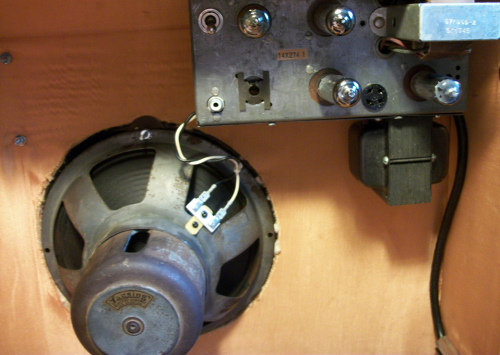Most guitarists go for speakers that are at least 10” and sometimes as large as 15” when designing their performance amplifiers, and while a bigger speaker may be better for sonic power on-stage, that’s not always what you’re looking for.
A smaller amp with a good 8” speaker can let you sound good while you’re practicing without waking up the entire neighborhood or let you use your overdrive without overwhelming the crowd in a smaller bar or club show, and is a helpful and relatively inexpensive addition to your equipment arsenal.
Here are our recommendations for the four best 8 inch guitar speakers on the market:
Jensen Vintage Alnico P8R8 8-inch Speaker
If you’re a blues or jazz guitarist, you’ll love the warmth of the Jensen Alnico’s sweet vintage tone. The Alnico (see full specs) is not a speaker for the player who wants their amp to go to 11. They play their best at lower levels, giving you an intimate and mellow sound that’s perfect for small club venues. The magnet that’s the speaker’s namesake is made of a unique combination of aluminum, nickel, and cobalt (hence, AlNiCo). The combination of metals gives these speakers a sensitive response and distinct distortion reminiscent of the original Fender Bassman or Super Reverb.
Jensen MOD-8 8-inch Speaker
Yes, we’ve picked another product from Jensen. About a third of the price of the Alnico, the MOD-8 gives you a crystal-clear sound with just a shimmer of vintage British tone. The MOD-8 gives you a more rounded version of the typical clear Jensen tone, dialing back the brightness in the high end and adding a mellow fuzz to the overdrive distortion. It’s designed with precision amplifiers in mind and works great as a replacement speaker in a practice amp, or to upgrade the sound quality of any smaller amplifier. Clearly, it’s one of the best 8 inch guitar speakers for the money.
Eminence Patriot 820H 8-inch Speaker
The Patriot 820H is perfect if you’re looking for the classic American tone from your cabinet or amp. It’s great for lead players, with a strong mid-range, rich bass, and excellent definition in the highs. This model has a hemp cone, similar to the line’s Cannabis Rex model, which gives the speaker an extra smooth tone compared to more rigid designs. The 820H (see full specs) has a big sound for an 8” speaker and compliments a wide range of amps and cabinets, even vintage Fenders that would overwhelm most speakers of its size.
Celestion 15 Ceramic 8-inch Speaker
If you’re looking for more of a British tone, consider the Celestion Eight. It gives you a balanced tone across its range, with a good punch in the low range and highs that crisp without sounding brittle or too bright. This speaker works best for smaller spaces and will be an ideal replacement for the speaker in your practice or rehearsal amp, or for when you’re recording. Considering it sets you back close to nothing, the Celestion Eight is also an excellent upgrade for an existing amp if you’re not happy with the sound but can’t afford a whole new cabinet. It will bring a new clarity to your tone you may not have realized your old amp was capable of producing. It’s one of the best 8 inch guitar speakers for the money.
Material Considerations of 8-inch Guitar Speakers
Most cones in guitar speakers are made of paper, though this may be infused with other fibers to increase its rigidity. A thinner cone material will make for a speaker that breaks up sooner but has a touch of natural compression, while a thicker material will have more power. Cones of other materials are less common and can give a unique touch to your sound. Hemp cones tend to have a sweeter, more organic sound, while ceramic cones are more rigid and will have a similar tonal quality to carbon-infused paper.
The materials used in the speaker’s magnet can also vary. Traditionally, speaker magnets were made from ferrite, a mix of ceramic and iron. Ferrite magnets have a long functional life and are effective, but are also very heavy.
The Alnico alloy used by Jensen is lighter than ferrite and tends to give speakers a mellower sound, though some people do complain that Alnico loses its magnetism faster than ferrite, making the speakers wear out more quickly.
Neodymium is another lighter alloy that’s become a popular speaker magnet material in recent years. It tends to combine the best aspects of ferrite and alnico magnets, both light-weight and durable, making higher-powered speakers smaller and increasing your power options.
Finding the Right Fit for the Best 8-inch Guitar Speakers
While the sound of your new speakers is certainly their most important quality, from a practical standpoint you need to make sure the speakers you’re looking at will fit right inside your cabinet. If you’re buying a replacement speaker, it may be helpful to shop within the same brand as the original. You’ll be more likely to get a speaker with a similar bolt-mounting pattern, eliminating the need to modify your amp.
In a similar vein, you want to match the diameter of the speaker you’re buying to what was installed before. Experienced repairmen and guitarists can alter some amps meant for an 8” speaker to house a 10” and vice-versa, but the housing will be the most secure when all the parts are the size they were intended to be.
If you’re replacing just one or two speakers out of a multi-speaker cabinet or amp, make sure the new speakers have a similar efficiency rating to the speakers you already have installed. If there’s a large disparity between the two, the speaker with the better efficiency will dominate the sonic texture, rendering the less efficient speakers useless in terms of their effect on your tone.
The speaker’s efficiency may also be called its sensitivity on the specifications sheet and will be measured in decibels (dB). If you can’t find the speaker’s efficiency, picking speakers with relatively similar power handling (the number measured in watts that is typically written somewhere on the speaker) will give you a similar indication of their relative presence in a combined sonic texture.








